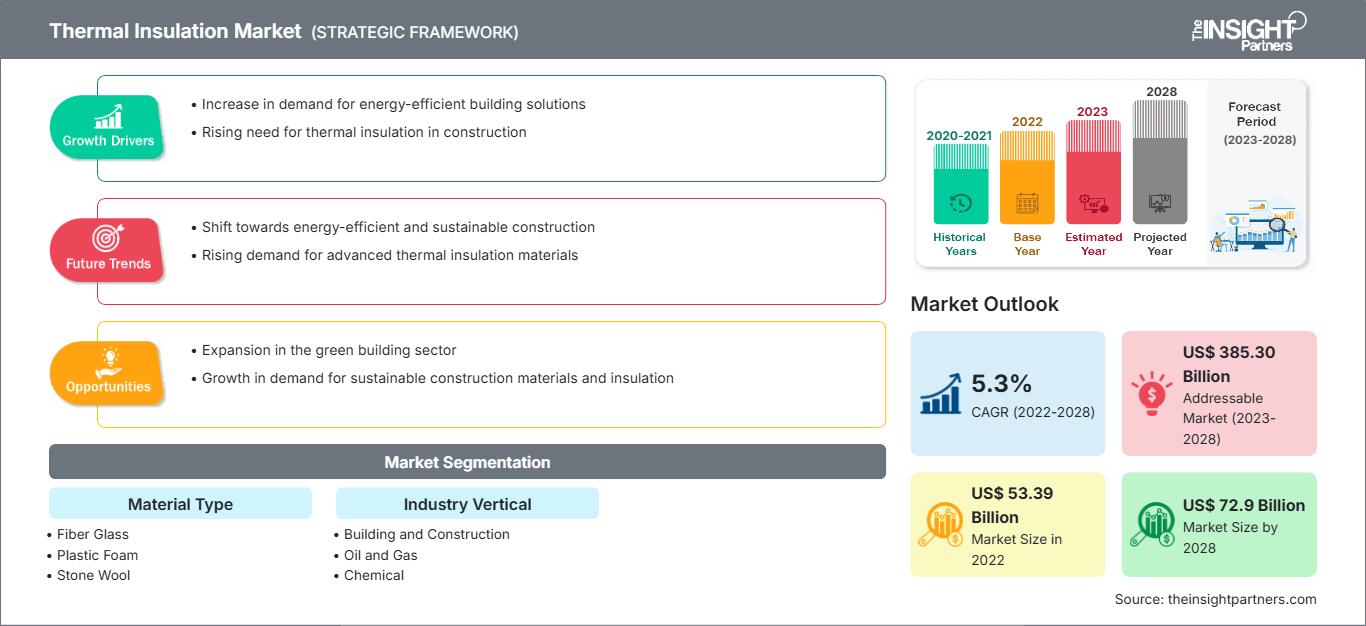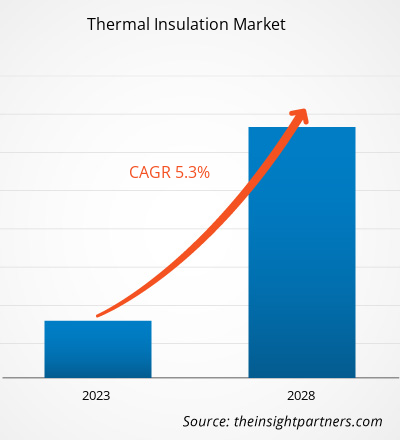단열재 시장은 2022년 533억 9천만 달러에서 2028년 729억 달러로 성장할 것으로 예상되며, 2022년부터 2028년까지 연평균 5.3% 성장할 것으로 예상됩니다.
단열재 수요는 단열재의 장점으로 인해 증가했습니다. 단열재는 에너지 비용을 절감하고 온도가 다른 두 물체 사이의 열 전달을 줄여줍니다. 단열재는 복사열을 반사, 감소, 흡수하는 단열재를 제공합니다. 기업들은 설치가 쉽고 시간과 노력이 적게 드는 플라스틱과 같은 경량 제품 공급에 집중하고 있습니다. 이러한 요인들이 단열재 시장 성장을 촉진할 것으로 예상됩니다.
BASF SE, Bayer AG, ROCKWOOL A/S, Johns Manville, SAINT GOBAIN SA, Kingspan Group PLC, Dow Chemicals Company, Owens Corning, Asahi Kasei Corporation, DuPont 등 유수 기업들의 강력한 입지로 인해 단열재 시장은 향후 몇 년간 상당한 성장을 보일 것으로 예상됩니다. 다양한 단열재 제품이 소비자들의 관심을 끌었습니다. 고온 및 열충격에 대한 내성, 낮은 열전도율, 환경적 이점, 비용 효율성 등 고온 단열재의 이점에 대한 인식이 높아짐에 따라 예측 기간 동안 단열재 시장 성장이 촉진될 것으로 예상됩니다.
2021년 아시아 태평양 지역은 세계 단열재 시장에서 가장 큰 점유율을 차지했습니다. 그러나 북미 지역은 예측 기간 동안 가장 높은 연평균 성장률을 기록할 것으로 예상됩니다. 아시아 태평양 시장은 중국, 인도, 호주, 일본, 한국 및 기타 아시아 태평양 지역으로 구분됩니다. 건설 산업은 아시아 태평양 지역에서 인구 급증으로 인해 급성장하는 산업 중 하나입니다. 이는 궁극적으로 단열재 제품에 대한 높은 수요로 이어집니다. 더욱이, 소비자들의 가처분소득 증가와 중산층 인구의 증가는 이 지역 단열재 시장 성장을 견인하는 주요 요인입니다.
요구 사항에 맞게 이 보고서를 사용자 정의하십시오.
이 보고서의 일부, 국가 수준 분석, Excel 데이터 팩을 포함하여 모든 보고서에 대한 사용자 정의를 무료로 받을 수 있을 뿐만 아니라 스타트업 및 대학을 위한 훌륭한 제안 및 할인을 이용할 수 있습니다
단열재 시장: 전략적 통찰력

- 이 보고서의 주요 주요 시장 동향을 확인하세요.이 무료 샘플에는 시장 동향부터 추정 및 예측에 이르기까지 데이터 분석이 포함됩니다.
이 보고서의 일부, 국가 수준 분석, Excel 데이터 팩을 포함하여 모든 보고서에 대한 사용자 정의를 무료로 받을 수 있을 뿐만 아니라 스타트업 및 대학을 위한 훌륭한 제안 및 할인을 이용할 수 있습니다
단열재 시장: 전략적 통찰력

- 이 보고서의 주요 주요 시장 동향을 확인하세요.이 무료 샘플에는 시장 동향부터 추정 및 예측에 이르기까지 데이터 분석이 포함됩니다.
COVID-19 팬데믹이 단열재 시장에 미치는 영향
COVID-19 팬데믹 이전에는 단열재 시장 성장이 주로 건물 및 건설 활동 수요 증가에 의해 주도되었습니다. 그러나 2020년 1분기에는 사업 중단, 원자재 및 인력 부족, 건설 및 운송 활동 감소로 인해 시장이 어려움을 겪었습니다. COVID-19 팬데믹은 2020년 초 경기 침체로 이어져 저소득층과 중산층 소비자에게 재정적 어려움을 안겨주었습니다.
더욱이, 여러 제한 조치로 인해 많은 건설 회사와 제조업체가 문을 닫으면서 단열재 시장 성장에 영향을 미쳤습니다. 더욱이, 팬데믹 기간 동안 단열재 업계는 인력 부족에 큰 어려움을 겪었습니다. 이로 인해 단열 산업은 기계화, 자동화 및 현장 외 제작으로 전환되었습니다.
시장 분석
단열재 사용의 이점
단열재는 열 이동과 증기 응축을 줄여줍니다. 따라서 건물 내부에서 발생할 수 있는 습기, 곰팡이, 동결, 변형 및 부식으로 인한 철재 부품의 약화를 방지하고 건물 보존에 도움을 줍니다. 또한, 다양한 산업 분야에서 BTU-BLOCK 단열재와 같은 제품을 활용하여 라이닝 시공 시 열전도율을 낮춰 막대한 에너지 절감 효과를 얻을 수 있습니다.
소재 유형에 따라 전 세계 시장은 유리 섬유, 플라스틱 폼, 스톤울, 규산칼슘, 셀룰러 유리 등으로 분류됩니다. 2021년에는 유리 섬유 부문이 가장 큰 매출 점유율을 차지했으며, 플라스틱 폼은 예측 기간 동안 가장 높은 성장률을 기록할 것으로 예상됩니다. 산업별로 보면, 세계 시장은 건축 및 건설, 석유 및 가스, 화학, 항공우주 및 방위, 자동차, 제약 등으로 세분화됩니다. 건축 및 건설 부문이 가장 큰 매출 점유율을 차지했습니다.
BASF SE, Bayer AG, ROCKWOOL A/S, Johns Manville, SAINT GOBAIN SA, Kingspan Group PLC, Dow Chemicals Company, Owens Corning, Asahi Kasei Corporation, DuPont 등이 단열재 시장의 주요 기업입니다. 이 회사들은 시장에 광범위한 제품 포트폴리오를 제공하며, 개발도상국에도 진출하여 수익성 높은 시장 기회를 제공합니다. 시장 참여자들은 고객 요구 사항을 충족하기 위해 고품질의 혁신적인 제품을 개발하고 있습니다.
보고서 스포트라이트
- 시장의 진보적인 산업 동향은 참여자들이 효과적인 장기 전략을 개발하는 데 도움이 됩니다.
- 선진국과 개발도상국 시장에서 채택한 사업 성장 전략
- 2022년부터 2028년까지 단열 제품 시장 규모에 대한 정량적 분석
- 전 세계 단열 수요 추산
- 산업에서 활동하는 구매자와 공급업체의 효율성을 보여주기 위한 PEST 분석
- 경쟁적인 시장 시나리오를 이해하기 위한 최근 개발
- 시장 동향 및 전망과 단열 시장 성장을 주도하고 제한하는 요소
- 상업적 관심을 뒷받침하고 시장 성장을 이끄는 시장 전략을 강조하여 의사 결정 프로세스 지원
- 다양한 노드에서의 단열 시장 규모
- 시장과 단열 산업에 대한 자세한 개요 및 세분화 역학
- 유망한 성장 기회를 가진 다양한 지역의 단열재 시장 규모
단열재 시장 지역별 통찰력
The Insight Partners의 분석가들은 예측 기간 동안 단열재 시장에 영향을 미치는 지역별 동향과 요인을 면밀히 분석했습니다. 이 섹션에서는 북미, 유럽, 아시아 태평양, 중동 및 아프리카, 중남미 지역의 단열재 시장 부문 및 지역별 분포도 살펴봅니다.
단열재 시장 보고서 범위
| 보고서 속성 | 세부 |
|---|---|
| 시장 규모 2022 | US$ 53.39 Billion |
| 시장규모별 2028 | US$ 72.9 Billion |
| 글로벌 CAGR (2022 - 2028) | 5.3% |
| 이전 데이터 | 2020-2021 |
| 예측 기간 | 2023-2028 |
| 다루는 세그먼트 |
By 재료 유형
|
| 포함된 지역 및 국가 | 북미
|
| 시장 선도 기업 및 주요 회사 프로필 |
|
단열재 시장 참여자 밀도: 비즈니스 역학에 미치는 영향 이해
단열재 시장은 소비자 선호도 변화, 기술 발전, 그리고 제품의 장점에 대한 인식 제고 등의 요인으로 인해 최종 사용자 수요가 증가함에 따라 빠르게 성장하고 있습니다. 수요가 증가함에 따라 기업들은 제품 라인업을 확장하고, 소비자 니즈를 충족하기 위한 혁신을 추진하며, 새로운 트렌드를 적극 활용하고 있으며, 이는 시장 성장을 더욱 가속화하고 있습니다.

- 을 얻으세요 단열재 시장 주요 주요 플레이어 개요
"2028년까지의 단열재 시장 분석"은 소비재 산업에 대한 전문적이고 심층적인 연구로, 특히 전 세계 단열재 시장 동향 분석에 중점을 두고 있습니다. 이 보고서는 상세한 시장 세분화를 통해 시장 개요를 제공하는 것을 목표로 합니다.
단열재 시장은 재료 유형, 산업 분야, 지역별로 세분화됩니다. 재료 유형에 따라 전 세계 시장은 유리 섬유, 플라스틱 폼, 스톤울, 규산칼슘, 셀룰러 유리 등으로 세분화됩니다. 산업 분야에 따라 전 세계 시장은 건축 및 건설, 석유 및 가스, 화학, 항공우주 및 방위, 자동차, 제약 등으로 세분화됩니다. 지역별로는 북미, 유럽, 아시아 태평양(APAC), 중동 및 아프리카(MEA), 그리고 남미 및 남미 지역으로 크게 세분화됩니다. 중앙 아메리카.
회사 프로필
BASF SE, Bayer AG, ROCKWOOL A/S, Johns Manville, SAINT GOBAIN SA, Kingspan Group PLC, Dow Chemicals Company, Owens Corning, Asahi Kasei Corporation, DuPont은 글로벌 단열재 시장에서 활동하는 대표적인 기업입니다.
- 과거 분석(2년), 기준 연도, CAGR을 포함한 예측(7년)
- PEST 및 SWOT 분석
- 시장 규모 가치/거래량 - 글로벌, 지역, 국가
- 산업 및 경쟁 환경
- Excel 데이터세트
최근 보고서
관련 보고서
사용 후기
구매 이유
- 정보에 기반한 의사 결정
- 시장 역학 이해
- 경쟁 분석
- 고객 인사이트
- 시장 예측
- 위험 완화
- 전략 기획
- 투자 타당성 분석
- 신흥 시장 파악
- 마케팅 전략 강화
- 운영 효율성 향상
- 규제 동향에 발맞춰 대응




















 무료 샘플 받기 - 단열재 시장
무료 샘플 받기 - 단열재 시장